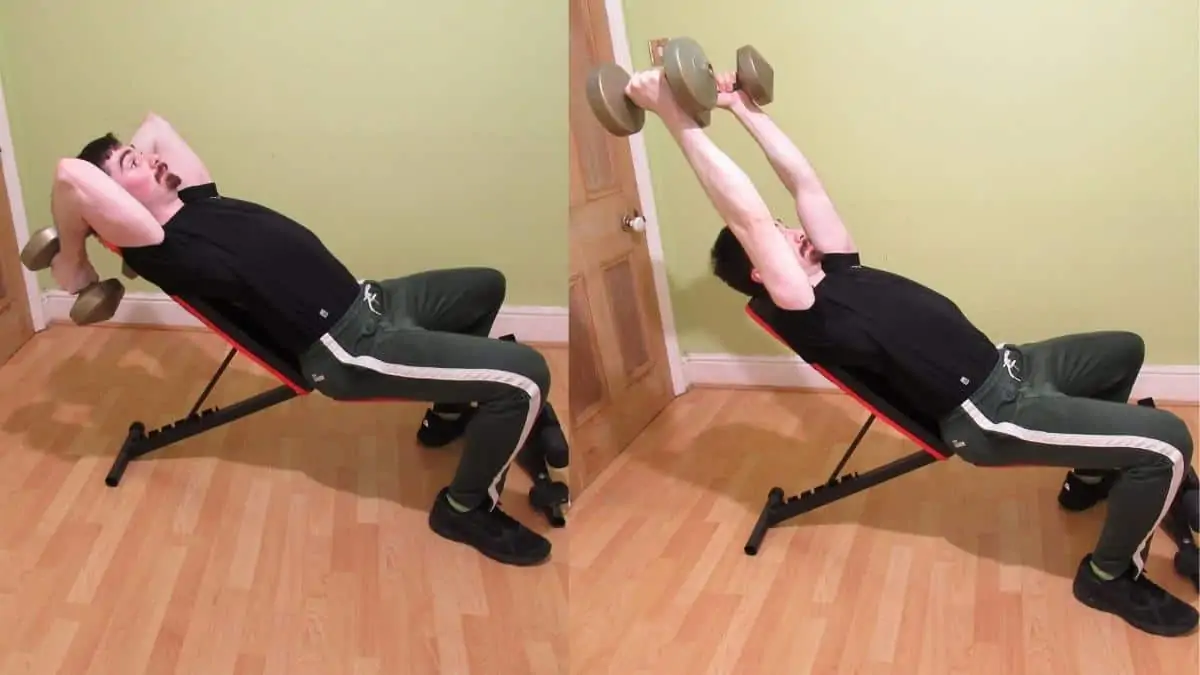The incline dumbbell tricep extension is an effective exercise for growing your arms because it trains all three heads of the triceps while giving particular emphasis to the most prominent head, the long head.
The following guide shows you how to do an incline dumbbell extension with the optimal tricep-building technique. You’ll then learn the benefits of the exercise and the proper form for five further variations of the incline triceps extension. This way, you’re not just limited to dumbbells.
Finally, you’ll find out how incline dumbbell extensions stack up against the flat lying dumbbell tricep extension when it comes to muscle hypertrophy and strength development.
Related: Seated dumbbell overhead extension│Cable incline tricep extension
Incline dumbbell extension exercise details
- Also Known As: Incline dumbbell overhead extensions, incline lying tricep extension
- Main Muscles: Triceps
- Exercise Type: Strength
- Exercise Mechanics: Isolation
- Difficulty Level: Intermediate
- Equipment Needed: Bench, dumbbells
How to do an incline dumbbell tricep extension
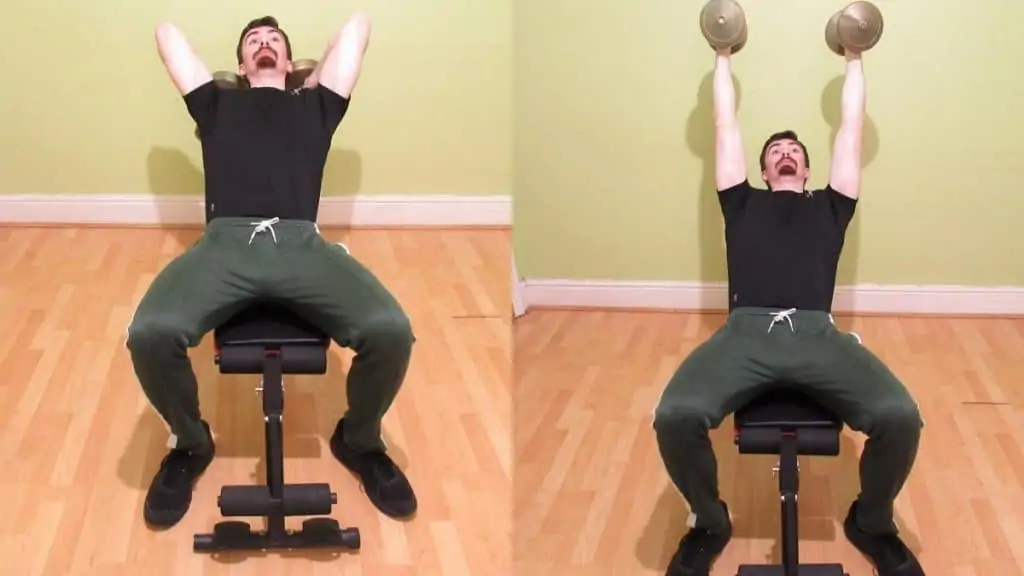
- Position the back pad of an adjustable bench at a 45-degree angle.
- Grab a pair of dumbbells with a neutral grip.
- Lie on the bench with your back against the pad.
- Press the weights up so that they’re directly over your face.
- Lower the dumbbells behind your head until you feel an intense triceps stretch.
- Descend until your biceps and forearms make contact at the bottom of the rep.
- Reverse the movement by flexing your triceps until your elbows reach full extension.
- Repeat for 3-5 sets of 8-20 reps.
Incline dumbbell tricep extension benefits
The dumbbell incline triceps extension is an underrated exercise that many lifters skip over in favor of more popular tricep extensions. Yet, incline dumbbell extensions possess some excellent muscle-building benefits that you can enjoy when you use the proper form.
Proportional triceps
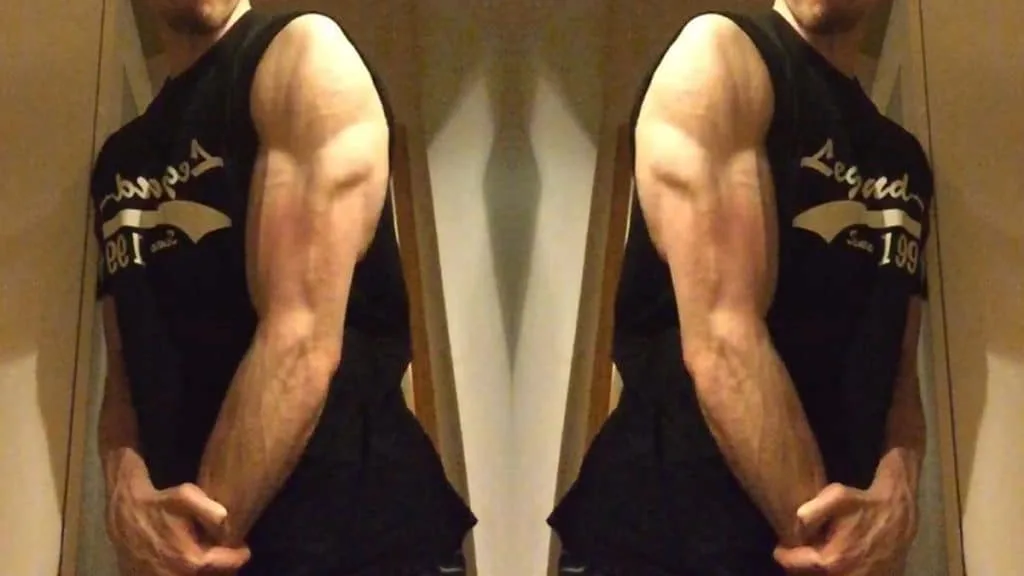
Like the decline DB triceps extension, the incline DB triceps extension is an effective exercise for building triceps that are not only big and muscular but symmetrical and aesthetic too.
This is because your stronger triceps muscle can’t dominate the movement (like it can when you use a barbell) because you have to lift each dumbbell independently. As such, when you perform incline overhead dumbbell extensions, both of your triceps will grow more or less in proportion because they’re receiving similar amounts of work.
Why just “more or less in proportion” and not completely symmetrically?
It’s because of the mind-muscle connection. There’s a good chance that you’re simply better at activating your stronger triceps muscle.
So even though you might be doing the same number of reps with both arms using an identical weight, your dominant arm may still get a better workout if you can more effectively stretch and squeeze that particular triceps muscle.
Training your triceps with dumbbells will, of course, help to bridge the gap between your weaker and stronger arms. But to improve your muscular imbalances as much as possible, make sure to really focus on your weaker arm so that you can become better at contracting it under resistance.
Stronger compound lifts

Many lifters don’t realize this, but there’s more to building a big bench press than just developing a huge chest; you need strong triceps as well.
After all, it’s your triceps, rather than your chest and shoulders, that are primarily responsible for locking out the weight during a bench press or overhead press.
And since you’re only as strong as your weakest link, you could have an Arnold-caliber chest and still struggle with locking out heavy barbells during your compound presses.
Strengthening your triceps via incline overhead dumbbell extensions is the way around this lockout problem. This is because, as in a compound press (triceps-wise at least), the most challenging part of a triceps extension is the lockout phase of the rep.
Additionally, since you’re doing the exercise on an incline bench, it has an especially good carryover to the incline bench press, which is a crucial exercise for maximizing your upper chest development.
So you can really see how getting strong at the incline lying tricep extension has more benefits than just increasing triceps strength during isolation exercises.
Bigger upper arms
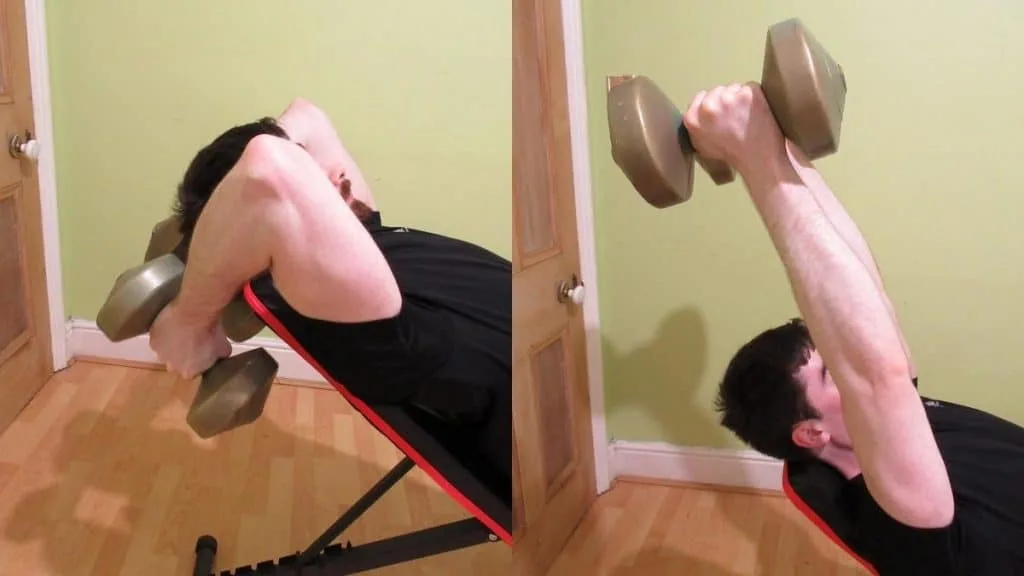
It can’t be said enough; if you want to grow your arms, then you need to increase the size of your triceps. Free weight tricep exercises like this are an excellent way to do just that.
You probably know that the triceps make up two-thirds of your upper arm size. But did you know that the long head of the triceps accounts for roughly two-thirds of your triceps mass?
What we can deduce from this anatomical fact is that you need to bring up your long head if you want to build your arms.
But unlike the medial and lateral heads, the long head has a dual function—elbow extension and shoulder extension. So training this muscle isn’t as simple as doing a few pushdowns and then drinking a protein shake; you need an intelligent exercise selection if you want to get optimal results.
Specifically, you need to combine elbow extension (a feature of any tricep exercise) with some shoulder movement so that you can maximally activate the long head.
In practice, this means lowering the dumbbells behind the bench rather than to your face so that you can place the long head under an intense stretch.
The feeling in your triceps when you get this positioning right can only be described as skin-splitting. You’ll feel like you’ve hit the hypertrophy jackpot because your triceps, now that they’re getting a proper stretch, will be primed to grow bigger.
Incline tricep extension variations
Besides the incline dumbbell triceps extension, there are five additional variations that you can do with a variety of other training tools. Each version, of course, has its pros and cons, so be sure to check out the different exercises to learn which one is best for you.
One arm incline triceps extension
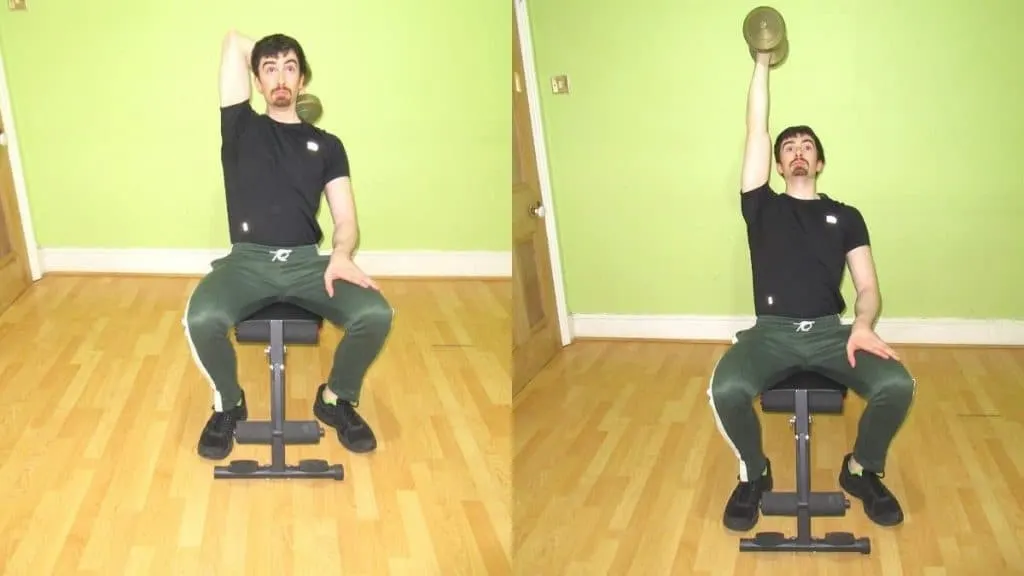
Performing an incline one arm dumbbell lying tricep extension really lets you hone in on each of your triceps to ensure that they’re getting equal amounts of stimulation. In this regard, it’s very similar to the lying cross body tricep extension, which you can also do on an incline bench.
But what’s the advantage to training each arm separately if you’re already using dumbbells?
That’s an easy one to answer: enhanced focus.
Your brain doesn’t have to split its focus across two limbs when you’re training each arm separately.
When you only have to think about moving one side of your body, you’ll naturally be able to give each arm a better workout because you can channel all of your strength and energy into training each particular triceps muscle.
The drawback is that your sets will take longer. So if you’re pressed for time, then you might want to stick with the regular incline dumbbell extension. But if you have noticeable muscular imbalances, then the extra symmetry gains that will result from this unilateral exercise may well be worth the extra gym time.
Alternating incline dumbbell overhead extensions
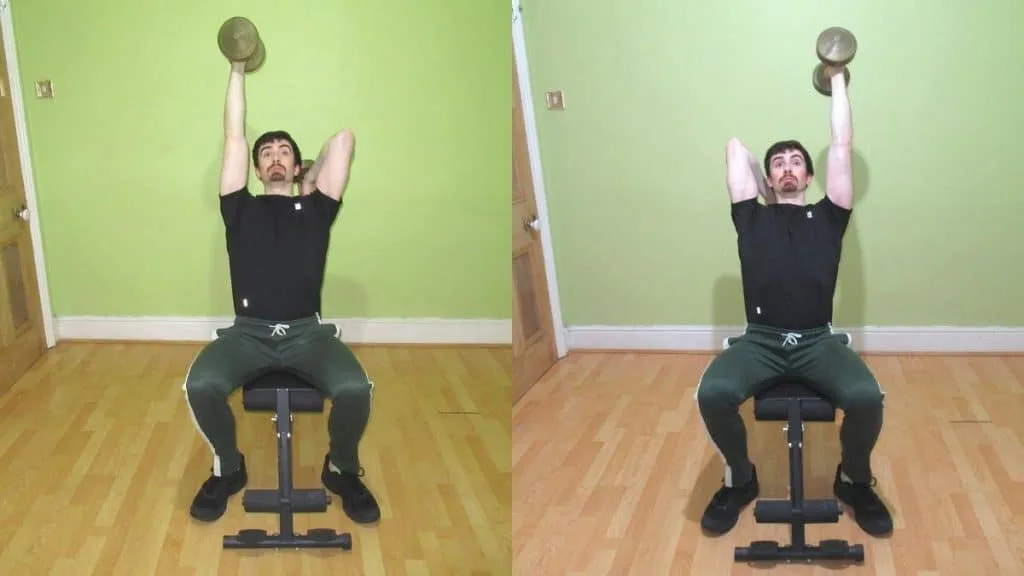
The incline alternate lying dumbbell extension is a good middle ground between regular incline dumbbell extensions and the single arm version.
No, you’re not training each of your triceps completely separately, but you’re also not lifting both of the weights together.
So while you still have to hold both weights, you’re not actually lifting them together, which means that you can still focus intensely on each of your triceps like you can in the single arm version.
Moreover, since each of your triceps gets a short recovery period while your other side is working, you’ll naturally be able to perform more reps on every set because your muscles will be less fatigued.
Barbell incline triceps extension
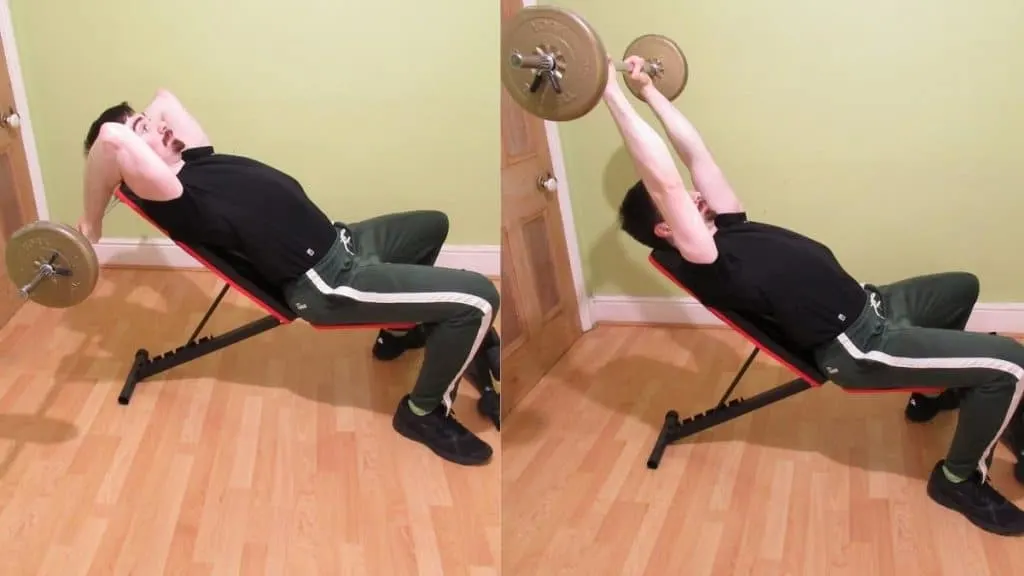
If you just want to overload your triceps with the most resistance possible, then do the incline barbell triceps extension.
Since barbells require less stabilization than dumbbells, they’re more conducive to maximal lifting.
Considering that the triceps are a muscle group that consists of predominantly fast-twitch muscle fibers, they respond particularly well to low reps and heavy weights.
But since the elbows can’t take as much of a beating as larger joints, you should stick to moderate or high reps (8-20) so that you don’t strain your connective tissue strictures.
The main downside of using a barbell for the incline lying tricep extension is that it forces your hands into full pronation, which can put a lot of pressure on your wrists—especially if you’re lifting heavy.
Thankfully, there’s an easy fix. Or should I say an “easy curl” fix?
EZ bar incline tricep extension
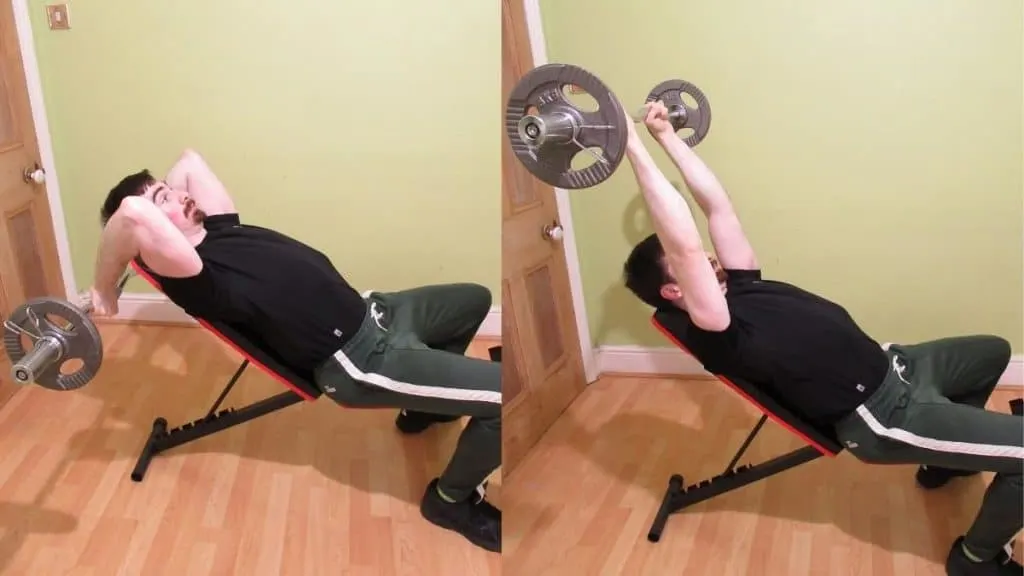
The EZ bar incline tricep extension places less strain on your wrists than its barbell counterpart because it has semi-pronated grips, which are much more comfortable to hold.
Of course, an easy curl bar is still a type of barbell, so you are still leaving yourself open to tricep size asymmetries by using an EZ bar.
Nonetheless, there’s nothing wrong with using bars for triceps training as long as you lift dumbbells as well. That is presuming, of course, that you’re in pursuit of maximum aesthetics.
If your form is good (i.e., if you don’t let the bar become too lopsided), then you can definitely train with barbells exclusively and still avoid any extreme muscular imbalances.
The resistance band overhead tricep extension is another good arm-building option for those without access to free weights. If you have both bands and free weights, however, then you can actually hook your bands up to the bar to make the movement more challenging at the top of the rep, which in turn will enhance your triceps pump.
Incline tricep extension vs flat tricep extension
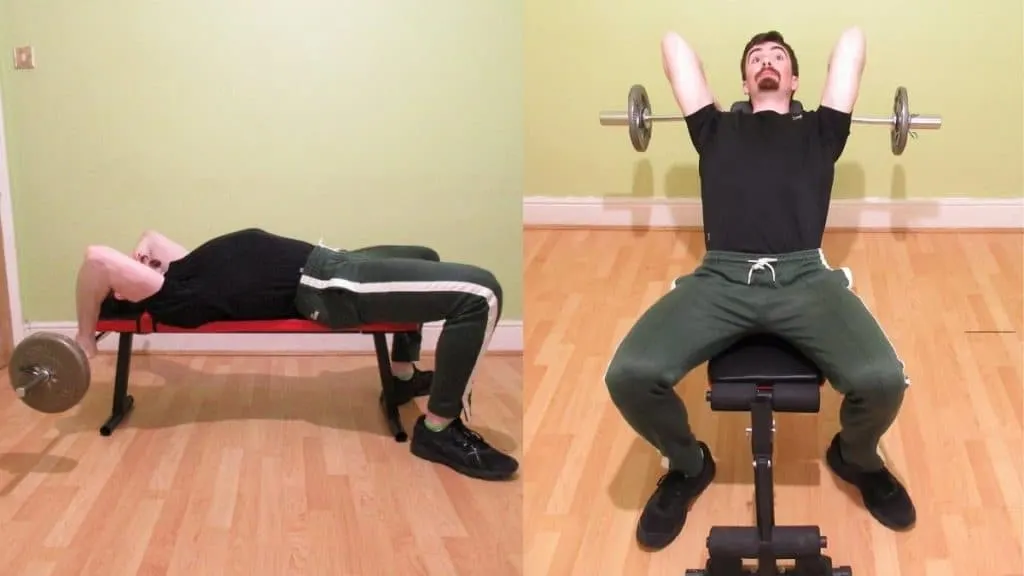
The incline tricep extension is a cross between flat extensions and overhead extensions.
For this reason, the incline variation often puts more pressure on your rotator cuffs than the flat version because your shoulders are under more direct force.
Similarly, it’s possible that you could get stuck with the weights behind the bench during incline dumbbell overhead extensions.
You’re not likely to get stuck with dumbbells, however, because if your triceps reach failure, then you can just bring your lats into the movement to get the weights to safety.
Yet, if your triceps reach failure when you’re using a barbell, then you can’t bring the bar forward because the back pad would be in the way.
For this reason, the flat version is definitely safer. But in terms of muscle activation and overall effectiveness, there’s minimal difference between the two exercises.
The flat extension allows you to roll your shoulders more, which may increase activation in the long head of your triceps.
Read More: Plate overhead tricep extension│Kettlebell overhead tricep extension
Conclusion: Should you do incline dumbbell extensions for your triceps?
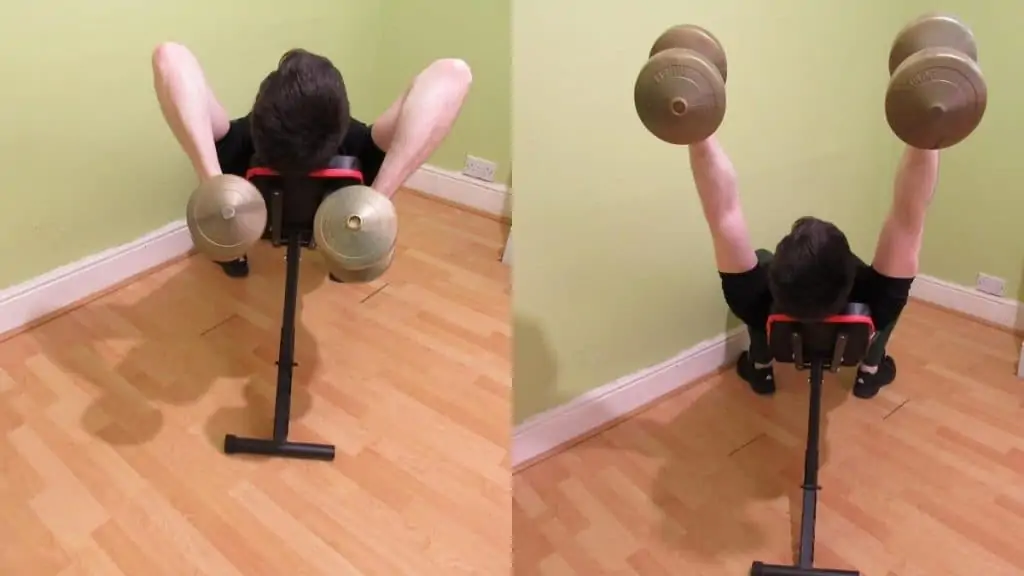
The incline dumbbell extension is the best version of the incline triceps extension because, as mentioned, you can’t get stuck with the weights behind the bench when your triceps reach failure because you can always use your lats to help your arms out.
Contrast this with the barbell version, where training to failure can be rather dangerous unless you have a competent spotter at your service, and you can see just how safe and effective the incline DB tricep extension really is.
The incline dumbbell tricep extension is also a helpful exercise for building proportional arms because your stronger side can’t dominate the movement when you’re lifting both weights independently.

